|
February 17, 2006
Presenting: Canada's Largest and Most Popular
Museum - The Canadian Museum of Civilization
My recent
trip to Ottawa last weekend gave me a chance to explore Canada's
capital first-hand. One place I did not have time to visit this
time was Canada's largest and most visited museum: the Canadian
Museum of Civilization.
An architectural masterpiece, the Museum offers a thousand years
of Canadian history. It also holds the world's largest indoor collection
of totem poles and the magnificent First Peoples Hall. You can also
visit the IMAX® Theatre, the Canadian Children's Museum, the
Canadian Postal Museum and a variety of special exhibitions.
To get a better idea of this celebrated museum I had a chance to
talk to Yasmine Mingay from the Canadian Museum of Civlization who
gave me a great overview of this unique institution.
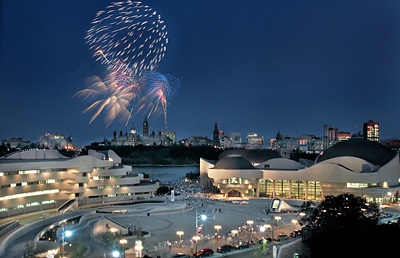
1. Please tell us about the Canadian Museum of Civilization.
How long has it been in existence? Where is it located? How can
I get there?
The Canadian Museum of Civilization began its life in May 1856,
as part of the Geological Survey of Canada. The young museum grew
into the National Museum of Canada and then, into the National Museum
of Man. In 1986, it became the Canadian Museum of Civilization,
moving into its magnificent Gatineau buildings three years later.
The Canadian Museum of Civilization (CMC) is Canada’s largest
and most popular cultural institution, attracting over 1.3 million
visitors each year. Located on the shores of the Ottawa River in
Gatineau, Quebec, the Museum offers a spectacular view of the Parliament
buildings across the river.
2. What is the mission of the Canadian Museum of Civilization?
The mandate of the Canadian Museum of Civilization is “to
increase, throughout Canada and internationally, interest in, knowledge
and critical understanding of, and appreciation and respect for,
human cultural achievements and human behaviour, by establishing,
maintaining and developing for research and posterity a collection
of objects of historical or cultural interest, with special, but
not exclusive, reference to Canada, and by demonstrating those achievements
and behaviour, the knowledge derived from them and the understanding
they represent.”
3. The building is rather unique. Please tell us about
the architecture of your museum.
Designed by Native-Canadian architect Douglas Cardinal, the Canadian
Museum of Civilization is considered one of the most striking architectural
masterpieces of the twentieth century. The award-winning building,
with its dramatic, curved lines, attracts admirers from all over
the world and is considered essential viewing for anyone visiting
the National Capital Region.
Douglas J. Cardinal was born in Calgary, Alberta in 1934, the eldest
of eight children. In 1953, he enrolled at the University of British
Columbia’s School of Architecture, and in 1956 pursued his
studies at the University of Texas in Austin, graduating in 1963
with a Bachelor of Architecture (Honours).
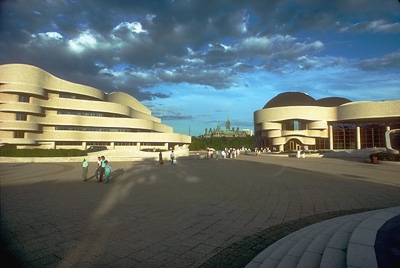
When asked about his design for the Canadian Museum of Civilization,
architect Douglas Cardinal replied, “The Museum will be symbolic
in form. It will speak of the emergence of this continent, its forms
sculpted by the winds, the rivers, the glaciers. It will speak of
the emergence of humanity from the melting glaciers, of man and
woman living in harmony with the forces of nature and evolving with
them. It will show the way in which men and women first learned
to cope with the environment, then mastered it and shaped it to
the needs of their own goals and aspirations.”
The building covers approximately 100,000 square metres (1,076,400
sq. ft.) and consists of two distinct pavilions. The Museum Building
houses public exhibitions in over 25,000 square metres (270,000
sq. ft.) of display space. The administrative Curatorial Building
contains the collections (four million artifacts), conservation
laboratories and staff offices.
4. Please talk to us about your three major galleries, the
Grand Hall, Canada Hall, First People's Hall.
Our permanent exhibitions are located in the 3 major galleries you
just mentioned. The majestic Grand Hall is the architectural centrepiece
of the Museum. This elliptical gallery measures 1,782 square metres
(19,182 sq. ft.), and has a 112 m x 15 m (365 ft. x 50 ft.) glass
wall, framing a breathtaking view of Parliament Hill and other important
national institutions. On the opposite wall, an immense scrim is
printed with a forest backdrop, making this the largest colour photograph
in the world. This dazzling setting makes the Grand Hall an ideal
showcase for the world’s largest indoor collection of totem
poles.
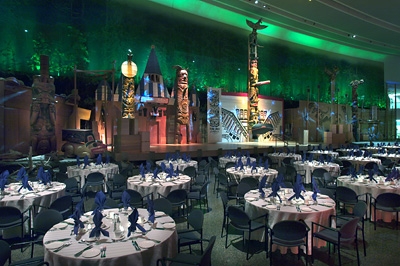
Developed in collaboration with Native Elders and artisans, the
Grand Hall celebrates the rich cultural heritage of the Native peoples
of the Northwest Coast. It is home to a dramatic exhibition of six
Native houses, each representing a different coastal nation and
linguistic group: Coast Salish, Nuu-Chah-Nulth (Nootka), Kwakwak’awakw
(Central Coast), Nuxalk (Bella Coola), Haida and Tsimshian. The
six house façades, constructed by Native craftsmen, are based
on coastal architectural styles of the past 150 years. The work
began in British Columbia, with final assembly undertaken at the
Museum. Storytelling sessions, demonstrations and performances are
held regularly in the Grand Hall.
After hours, the Hall, which has a seating capacity of 400, is
available for private receptions and banquets. In recent years,
the Grand Hall has provided a stunning setting for the state visits
of Queen Elizabeth, Prince Charles, British Prime Minister Tony
Blair, U.S. President Bill Clinton, Mexican President Vicente Fox,
and many other world leaders.
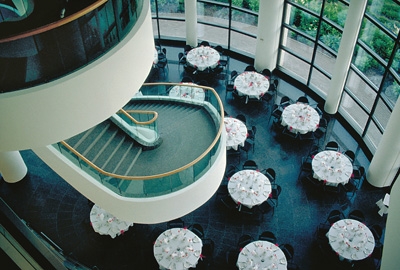
The Canada Hall leads visitors on a remarkable journey through one
thousand years of Canada’s social history. A panorama of Canadian
history unfolds in an area covering over 3,000 square metres (32,300
sq. ft.), with a 17-metre (56-ft.) domed ceiling. The Canada Hall
has been developed in two sections. The first focuses on the Atlantic
region, Quebec and Ontario from 1000 to 1885. The second covers
Western and Northern Canada from 1885 to the present.
The first section of the Canada Hall includes reconstructed scenes
of early European activity: a Norse landing in Newfoundland in A.D.
1000, as well as the interior of a Basque ship and a whaling station
— both dating from about 1560. An Acadian exhibit, a New France
farmhouse and public square, an inn, a hospital, a shoemaker’s
house and a cooper’s house all illustrate life in New France
from 1600 to 1760. A voyageur camp, a Conestoga wagon, a lumber
camp shanty and a Métis campsite represent expanding frontiers
from 1680 to 1860. For the period between 1760 and 1885, visitors
are conducted through British military quarters, a shipyard and
a main street in late nineteenth-century Ontario.
The second section of the Canada Hall showcases the West and the
North in historical settings. Displays currently include a turn-of-the-century
railway station and railway yard, a Saskatchewan grain elevator,
a Ukrainian church that was moved here from Alberta, scenes from
the Winnipeg General Strike of 1919, a Chinese hand laundry and
a 1920s Alberta oil derrick. This section illustrates urban development
in the early industrial era (1890–1940). It includes a West
Coast fisheries scene and a reconstruction of Yellowknife’s
Wildcat Cafe, which provides a venue for stories from the North,
past and present.
The Museum’s newest permanent exhibition is the First Peoples
Hall, a 2,000-square-metre permanent exhibition hall, in the planning
for over a decade, that highlights the cultural, historical and
artistic achievements of Canada’s First Peoples.
The new exhibits contain more than 2,000 artifacts, works of art,
documents and illustrations. They reveal the many aspects of Aboriginal
peoples, from earliest origins to the present day, and underline
their fight for cultural survival
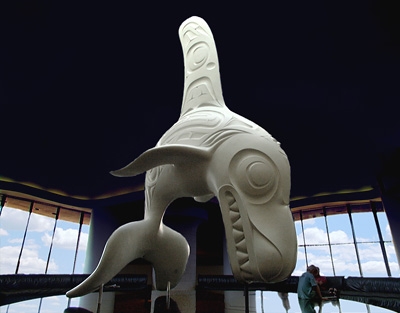
5. What about the exhibitions that are currently running?
In addition to numerous permanent exhibitions throughout the Museum,
the CMC presents over 15 special exhibitions each year. Currently
the following exhibitions are presented at the CMC:
Lace Up: Canada’s Passion for Skating -A new exhibition
at the Canadian Museum of Civilization tells the story of how skating
has become one of the country’s most popular winter activities,
intrinsic to life in Canada. Lace Up: Canada’s Passion for
Skating is the first exhibition to explore the history of how the
three ice sports of figure skating, hockey and speed skating developed
in Canada. Now on at the Canadian Museum of Civilization until March
4, 2007.
Beads of Life: Eastern and Southern African Adornments
- Extended until September 10, 2006. Since its opening on April
15, 2005, more than 100,000 visitors have seen this colourful exhibition
that showcases for one of Africa’s most vibrant and enduring
art forms and opens a window onto the contemporary forms and economic
issues related to the artistry, history and meaning of African beaded
adornments.
A Caring Profession: Centuries of Nursing in Canada -Throughout
Canada’s history, the care and compassion of nurses have made
the difference between life and death in our hospitals, homes and
schools, as well as on battlefields and in the country’s remotest
outposts. The compelling stories of Canada’s nurses are told
in A Caring Profession: Centuries of Nursing in Canada, the most
extensive exhibition to examine on the impact of nursing on the
lives of Canadians, presented at the Canadian Museum of Civilization
until July 30, 2006.
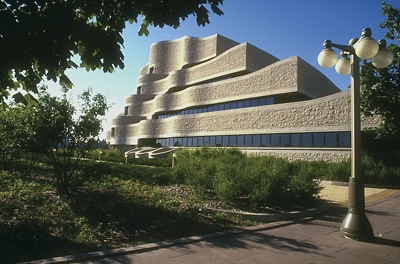
6. Please tell us about some of the Arts and Craft and Treasures
exhibitions that have been held the Canadian Museum of Civilization.
The Museum has presented and co-produced a number of magnificent
exhibitions including the following:
In 2002 we presented the exhibition The Mysterious
Bog People: Rituals and Sacrifice in Ancient Europe.
Since ancient times, bogs had a particular significance for people
who lived in northwestern Europe. Shrouded in mists and often seeming
dangerous and frightening, the bogs were used by local people to
sacrifice their most valuable items in rituals that remain a mystery
to this day.
This exhibition was a joint project of the Drents Museum (Assen,
Netherlands), the Niedersächsisches Landesmuseum (Hanover,
Germany), the Canadian Museum of Civilization and the Glenbow Museum
(Calgary) and is the most comprehensive ever produced on the rituals
of people living in North-western Europe in prehistoric times. It
presented the latest research on the mysterious bog people who are
little known to most of us
Arguably one of our most successful and much talked about exhibitions
was Ancient Treasures and the Dead Sea Scrolls,
presented in 2003 / 2004.This extraordinary exhibition was a once-in-a-lifetime
opportunity for visitors to see a hundred extremely rare artifacts
and manuscripts from the Biblical period, many of them never before
seen outside Israel. Through these unique archaeological finds,
discover over a thousand years of ancient history and the roots
of two world religions, Judaism and Christianity.
In 1947, the first seven Dead Sea Scrolls were discovered in a
desert cave by a young Bedouin shepherd searching for a lost goat.
Over the next decade, archaeologists and Bedouins found portions
of more than 900 scrolls in 11 nearby caves. Dated to the late Second
Temple period (167 B.C.E. to 70 C.E.), the Dead Sea Scrolls are
1,000 years older Ancient Treasures and the Dead Sea Scrolls presented
archaeological finds uncovered in Jerusalem, Massada, Qumram, and
other cities of the biblical and Roman eras. They included three
of the first Dead Sea Scrolls discovered, as well as the only known
artifacts tied to the dynasty of King David. Also on display were
personal and household items, such as jewelry, toys and cooking
pots that spoke to the daily life in the ancient Holy Land.
In 2 months we will be presenting PETRA: Lost City
of Stone - Founded in the first century B.C., Petra
prospered for centuries at the confluence of the famous silk and
spice roads, two of the greatest trade routes in world history in
thwe desert of southern Jordan. The city drew its wealth from the
camel caravans that ferried precious cargoes from India and Arabia
to markets in Greece, Rome, Egypt and Syria. Its founders, the Nabataeans,
are still hailed for their business acumen, artistic talents, and
technical innovations. The fascinating city of Petra, with monumental
stone-carved architecture and elaborate waterworks engineering is
considered one of the most significant sites of antiquity. This
exhibition will allow visitors a chance to rediscover a largely
untold chapter of world history and behold more than 170 exceptional
artifacts from museums in Jordan, Europe and the United States.
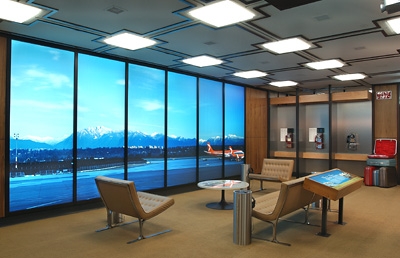
7. You also have held exhibitions on archeology, history
and military history. Please tell us more about that.
The Canadian Museum of Civilization is primarily dedicated to the
collection, preservation and telling of Canadian History and we
have produced and presented some amazing exhibitions on our collective
heritage.
From November 2003 to January 9, 2005 the CMC presented the exhibition
Across Time and Tundra: The Inuvialuit of the Canadian
Arctic. Inuit living in the western Canadian Arctic
call themselves "Inuvialuit", meaning "real human
beings", and have long considered themselves distinct from
other Canadian Inuit. Today this distinct identity has a political
dimension; the Inuvialuit chose not to join Nunavut (the new Inuit
territory in the eastern Arctic), but to remain in the Northwest
Territories under their own land claim agreement. The exhibition
"Inuvialuit" explores the history of this unique Arctic
people, from their first arrival in the Canadian Arctic from Alaska
about a thousand years ago to the modern era. The exhibition highlights
material collected by fur trader Roderick MacFarlane in the 1860s,
and the photographic resources of the Anglican Archives, dating
from the 1890s and was curated by Dr. David Morrison, Director of
History and Archaeology at the Museum based on 20 years of research
.
In June of 2004, the CMC opened a major new exhibition, Once
in French America produced in celebration of the 400th
anniversary of French settlement in North America. The guiding principle
behind the exhibition was an examination of how new societies developed
in North America. During the seventeenth and eighteenth centuries,
immigrants to New France arrived with certain traditions, behaviors
and institutions. However, in order to survive and prosper in a
challenging new environment they also had to adapt everything they
knew — often borrowing heavily from the traditions and technologies
of First Peoples, as well as developing new methodologies of their
own. The early settlers of New France were thus able to create and
sustain societies with a vitality and influence that continues to
this day. The exhibition featured approximately 500 artifacts and
objects, representing all facets of life in New France drawn from
some 40 institutions in Canada, the United States and France, bringing
together one of the most extensive collections of New France artifacts
for the very first time.
This past year we were also proud to present Acres of
Dreams – Settling in the Canadian Prairies.
This exhibition introduced visitors to the history of changing idealistic
impressions of the West and explored the story of how and why the
West has been perceived as a Canadian Utopia for the last 150 years.
Visitors discovered a crucial chapter in Canada's history, focusing
on the challenges and experiences of millions of settlers, and the
extraordinary international marketing campaign launched by the government
to lure them to the West.
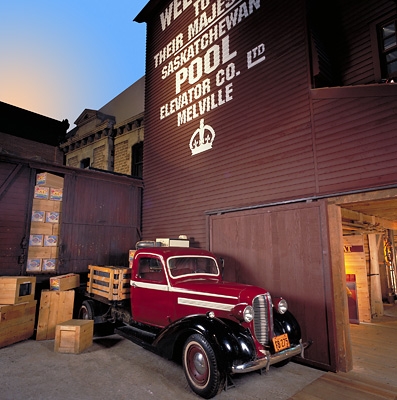
By launching the exhibit in 2005, the anniversary of the creation
of the provinces of Saskatchewan and Alberta, the Museum took a
national leadership role in celebrating this seminal date while
presenting a major Western Canadian story that has never before
been exhibited in either the East or West. This exhibition speaks
to all Canadians of the great beauty of the Western land, and of
the riches of its natural resources and showed that Prairie optimism
endures, as new energy sources are found, and as pluralistic societies
find a place for themselves in communities across the West.The exhibition
was developed by the Canadian Museum of Civilization in collaboration
with Library and Archives Canada.
8. The Canadian Museum of Civilization also houses an Imax
Theatre, the Canadian Children's Museum and the Canadian Postal
Museum. Please tell us more about that.
The Canadian Children’s Museum has been one of the
Canadian Museum of Civilization’s most popular attractions
since it opened in 1989. Now almost three times its original size,
the Canadian Children’s Museum (CCM) takes visitors of all
ages on a Great Adventure. CCM passports in hand, visitors discover
one incredible destination after another — from a mini-excursion
to homes in the International Village, to a side trip to
the World Exchange, the Kids’ Café,
Building Works or Clothing Company. Whether on
a trek to a desert pyramid, a jaunt to the Port of Entry to help
unload a cargo ship, or a stroll through the bustling Market Bazaar,
visitors encounter endless ways to learn about the world and each
other.
The Canadian Postal Museum (CPM), founded in 1974, tells
the story of postal communications in Canada and around the world.
In 1988, the CPM joined the Canadian Museum of Civilization (CMC),
and in June 1997, it officially opened its permanent premises inside
the CMC. The programming of the Canadian Postal Museum has evolved
over the years in response to its public. Since the Museum opened,
visitors have been able to see multimedia presentations, art exhibitions,
technological exhibitions, exhibitions of objects in the collection
and thematic exhibitions illustrating how Canadians have communicated
in writing with one another and with the rest of the world.
Visitors to the CPM can explore a number of interactive exhibitions
including Stamp Quest™, an amusing introduction to
the world of postage stamps and stamp collecting. The Reflections
of Canada exhibition presents for the first time under the
same roof a copy of every postage stamp ever issued in Canada and
its provinces, a total of nearly 2,500 stamps. In this exhibition,
visitors can use computer stations to consult the Canadian Postal
Archives site or view the popular Heritage Minutes. A school programme
complements the exhibition.
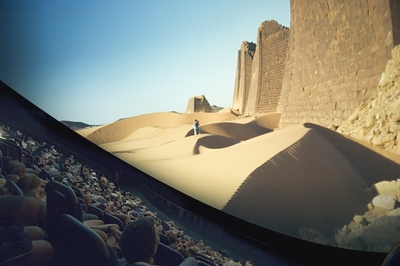
The Canadian Museum of Civilization’s IMAX® Theatre
is the first of its kind in the world to combine two IMAX technologies.
The giant IMAX screen is ten times the size of conventional movie
screens and shows an image of stunning clarity. The IMAX DOME screen
is a massive dome which tilts into place over the audience, providing
a panoramic view that is as good as being there!
The theatre has 295 seats that tilt back to give audience members
a full yet comfortable view. The vertical IMAX screen covers the
entire front wall of the theatre and is 26 metres (87 ft.) wide
and 19 metres (62 ft.) high. A second huge screen, the IMAX
DOME, slides out of sight when not in use. It is 23 metres
(76 ft.) in diameter and moves on an ingenious hoist system. The
dome apparatus weighs 8,600 kg (18,960 lbs.). All the technology
related to IMAX cameras and projectors was developed in Canada.
9. The Canadian Museum of Civilization also has a theatre
company. Please tell us more.
As one of North America’s first resident museum theatre companies,
Dramamuse has been delighting and enlightening visitors
at the Canadian Museum of Civilization since its first performance
on June 29, 1989. The company’s chief mandate is to interpret
the collections of the Canadian Museum of Civilization, which it
achieves by focusing primarily on short plays and visitor interaction
during Museum hours. Dramamuse currently has over 50 short plays
in its repertoire — varying in length from 8 to 25 minutes
— all performed against the impressive backdrop of the Museum’s
many exhibition halls. With its life-size reconstructions of historical
settings, the Canada Hall is a particularly appropriate theatre
venue, and it is there that numerous Dramamuse characters cross
paths, and mingle with, Museum visitors.
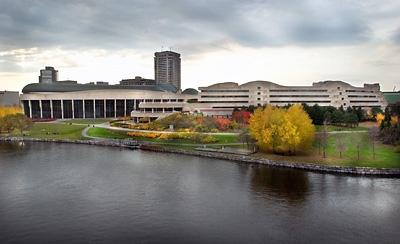
10. What are some of the big news and special events coming
up for the Canadian Museum of Civilization?
It’s hard to believe, but the Museum is really celebrating
its 150th anniversary! The origins of the Museum date back to 1856,
with the creation of the National Museum of Canada by the Geological
Survey of Canada. Later, it became the National Museum of Man. In
1986, it was named the Canadian Museum of Civilization, and three
years later, it moved to its present-day site in Gatineau. In honour
of its 150th anniversary, the Museum of Civilization is opening
a new long-term exhibition profiling the organization’s history
from its origins to the present day, The Canadian Museum of
Civilization: 150 Years of Cultural Exploration. A lively new
book on the history of the institution from its origins to the present
day, A World Inside: A 150-Year History of the Canadian Museum of
Civilization will also celebrate the often dramatic history of Canada’s
most popular museum.
The Museum will be holding an open house on May 14 and organizing
a variety of activities. There will be a barbecue and a birthday
cake, along with guided tours of the exhibitions and behind the
scenes, films, entertainment for all ages, meetings with curators
and more. Admission will be free, and most activities will be free
as well.
Thank you, Yasmine, for this great overview. I hope I'll be able
to visit the Canadian Museum of Civilization on one of my next trips
to Ottawa.
Related Articles:
Hello from Ottawa
- My 2-day packed itinerary for Winterlude
Hello from Ottawa - First
impressions and an overview
Hello from Ottawa - The Lord Elgin
Hotel: a historic landmark in the heart of Ottawa
Hello from Ottawa - Fat Tuesday's
and the Mardi Gras Experience in the ByWard Market
Hello from Ottawa - An early
morning walk to Parliament Hill
Hello from Ottawa - Skating
on the Rideau Canal, the World's Largest Skating Rink
Hello from Ottawa - Charity and
hilarity: the 26th Annual Bedzz Races on Dow's Lake
Hello from Ottawa - Confederation
Park and other Winterlude locations
Hello from Ottawa - Darcy McGee's:
a historic Irish pub on Sparks Street
Hello from Ottawa - The Canadian
War Museum and "Weapons of Mass Dissemination - The Propaganda
of War"
Hello from Ottawa - The
Canadian Museum of Contemporary Photography featuring Sunil Gupta
and the challenges of immigration
An interview with Tourism Ottawa
provides a great overview of this city
An interview about
the ByWard Market, a prime entertainment and shopping area
An interview
with the National Gallery of Canada
An interview
with the Canadian Museum of Civilization
Helpful websites:
Ottawa
Tourism: Ottawa's official tourism information
The ByWard
Market Business Improvement Area
The
National Capital Commission
The National
Museum of Civilization
The National Gallery
of Canada
The Canadian War
Museum
Useful books about Ottawa:
|